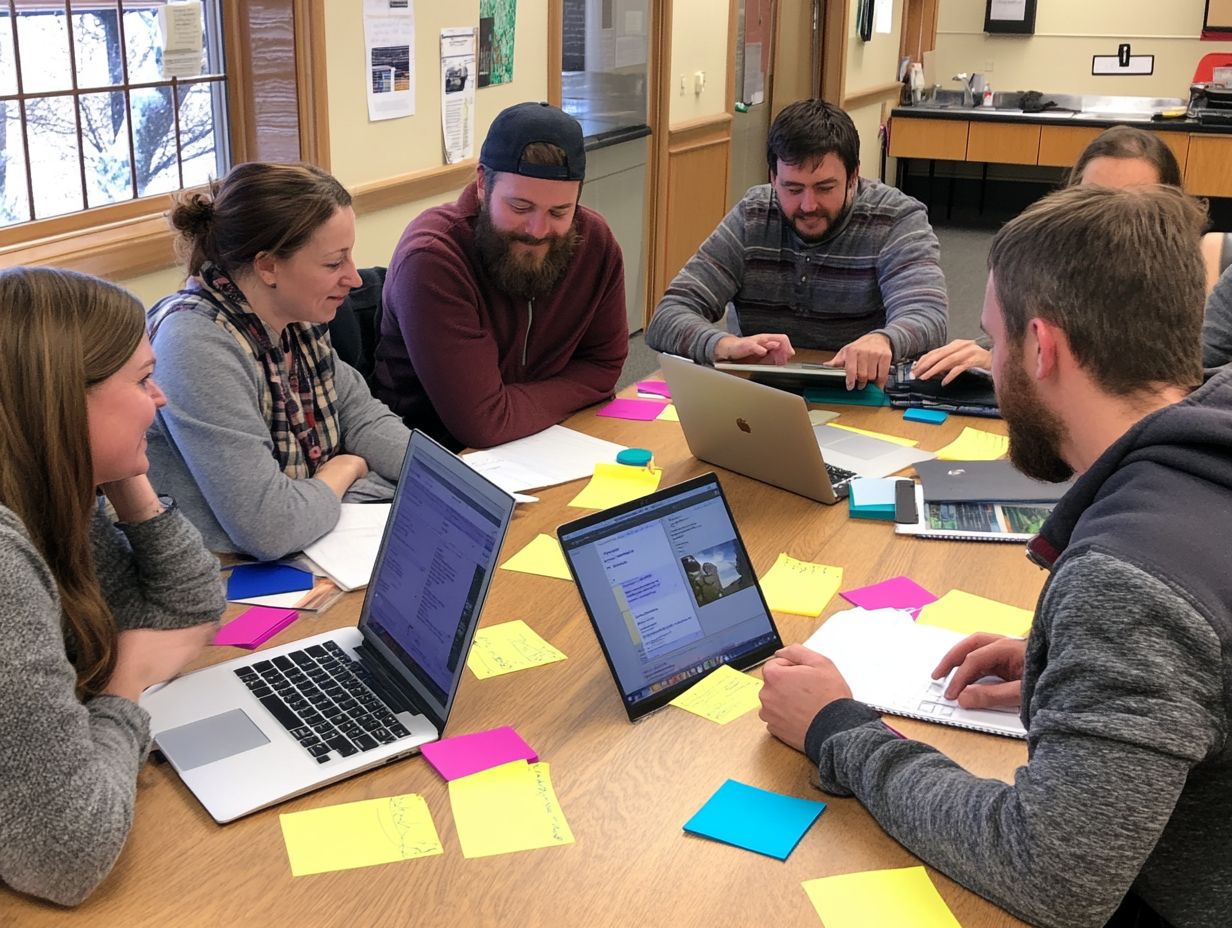Creating Effective Assessments for E-Learning
In the rapidly evolving world of e-learning, assessments are pivotal in shaping your learning experience. They serve as a barometer for your progress, boost engagement, and inform instructional strategies tailored to your needs.
This article delves into the importance of assessments, distinguishing between formative and summative methods while highlighting alternative strategies that may resonate with you.
You will also discover best practices for crafting effective assessments, implementing them with ease, and ensuring their ongoing improvement. Let s dive in and explore how assessments can revolutionize your learning!
Contents
- Key Takeaways:
- The Importance of Assessments in E-Learning
- Types of Assessments in E-Learning
- Designing Effective Assessments
- Implementing Assessments in E-Learning
- Evaluating and Improving Assessments
- Frequently Asked Questions
- 1. What is the importance of creating effective assessments for e-learning?
- 2. How can I create effective assessments for e-learning?
- 3. Should assessments be included throughout the e-learning course or only at the end?
- 4. Can I use assessments to personalize the learning experience for each learner?
- 5. How do I ensure that my assessments are fair and unbiased?
- 6. Can I use technology to create effective assessments for e-learning?
Key Takeaways:

- Assessments play a crucial role in e-learning by measuring the effectiveness of learning and providing valuable feedback to improve learning outcomes.
- Formative and summative assessments serve different purposes in e-learning and should be used in combination for a well-rounded evaluation of student progress.
- Effective assessment design requires careful consideration of learning objectives, alignment with course content, and use of best practices such as clear instructions and varied question types.
The Importance of Assessments in E-Learning
In the realm of eLearning, assessments hold an essential position in ensuring that learning objectives are achieved and learner engagement remains high. They are not merely tools for checking how well you remember the material; they also serve as critical components of instructional design that align seamlessly with corporate training goals.
By integrating diverse assessment types, such as formative and summative assessments, you can cultivate a learning environment that promotes continuous improvement while offering vital feedback mechanisms for both learners and instructors.
Why Assessments Matter in E-Learning
Assessments play a crucial role in eLearning, as they directly influence knowledge transfer and learner engagement, ultimately affecting your performance evaluation outcomes.
These evaluative tools not only gauge your understanding of the material but also significantly enhance retention by offering timely feedback. Thoughtfully crafted assessments encourage your active participation, enabling you to apply what you’ve learned in real-world scenarios. This connection between assessment and engagement deepens your comprehension of the subject matter, making training programs far more effective.
By tracking knowledge retention over time, organizations can continuously refine their training strategies, ensuring that you remain motivated and engaged throughout your educational journey.
Types of Assessments in E-Learning
In the realm of eLearning, you’ll encounter a diverse array of assessment types designed to effectively gauge your understanding and skills. These include:
- formative assessments, which provide ongoing feedback;
- summative assessments, which evaluate your learning at the end of a course;
- project-based assessments, which encourage practical application of knowledge.
Each type serves a unique purpose in your educational journey, ensuring a comprehensive evaluation of your capabilities.
Formative vs. Summative Assessments
Formative assessments are crafted to gauge your understanding during the learning journey, while summative assessments come into play to evaluate your knowledge at the conclusion of an instructional unit.
Both types hold distinct yet complementary roles in the educational landscape. Formative assessments think quizzes, class discussions, and observational techniques enable educators to pinpoint any learning gaps you might have. This allows them to adapt their teaching methods in real-time, offering you timely feedback and support.
On the flip side, summative assessments, like standardized tests and final projects, deliver a comprehensive snapshot of what you’ve absorbed. These assessments often carry significant weight in determining grades and evaluating the effectiveness of the curriculum.
By mixing these assessment methods, educators can tailor their approach just for you, giving you the best chance to shine!
Don t miss out on these strategies to enhance your learning! Start implementing effective assessments today!
Alternative Assessment Methods

Alternative assessment methods include qualitative testing, open-ended questions, and gamification. These innovative techniques help evaluate your knowledge and skills in exciting ways.
Such methods provide a broader view of your abilities. They also promote deeper engagement with the material.
By incorporating real-world scenarios and practical applications, these assessments encourage you to apply what you’ve learned in meaningful contexts.
This shift from rote memorization to critical thinking is particularly impactful in eLearning environments. Traditional assessments often miss the mark. As you navigate challenges that mirror real-life situations, you become better equipped to transfer your skills to future tasks, ultimately enhancing your comprehension and retention of information.
Designing Effective Assessments
Designing effective assessments requires a clear understanding of assessment principles. Ensure that performance criteria align with learning objectives and remain relevant.
This alignment is key to creating assessments that reflect the desired outcomes and improve the learning experience.
Key Considerations for Assessment Design
When designing assessments, consider factors like performance criteria and the diverse needs of learners. These elements help measure what is truly important while accommodating various learning styles.
Each assessment should clearly reflect learning objectives. Involving all stakeholders in development enhances relevance and effectiveness.
Recognizing the importance of formative assessments allows you to adapt teaching strategies that support student progress and engagement.
Best Practices for Creating Assessments
Effective assessments depend on clarity and relevance. Regularly tracking progress can elevate learner engagement and outcomes.
Your assessments should have clear objectives aligned with learning goals. They should reflect real-world applications to keep learners engaged.
Incorporating regular feedback fosters an ongoing dialogue between educators and students, helping to pinpoint areas for improvement and nurturing a growth mindset.
By focusing on these elements, educational institutions can enhance the effectiveness of their assessments and cultivate a more productive learning environment.
Implementing Assessments in E-Learning
For effective assessments in eLearning, choose the right assessment tools. Additionally, consider how to measure e-learning effectiveness and adopt strategies that boost learner engagement and educational effectiveness.
By selecting appropriate methods, you can enhance the learning experience and accurately reflect learners understanding and capabilities.
Strategies for Incorporating Assessments

Incorporating assessments into your eLearning courses requires a strategic approach. This approach focuses on using assessment tools to track progress and engage learners, while also considering key metrics for evaluating e-learning programs.
You can start by integrating formative assessments at regular intervals throughout your course. This not only provides immediate feedback but also gives you the power to pinpoint areas that need improvement.
Use interactive quizzes, polls, and reflection prompts. They can boost participation and keep learners motivated.
By leveraging data analysis tools, you can gain valuable insights into learner performance, enabling you to tailor support to meet individual needs. Data analysis tools help you understand learner performance better.
This personalized approach also fosters a sense of ownership among learners and cultivates a more immersive learning environment, enhancing both motivation and retention.
Blending different assessment strategies creates an engaging and dynamic learning experience that promotes continuous growth and development.
Tools and Technologies for Assessment Delivery
You have a wealth of tools and technologies at your disposal to enhance assessment delivery in eLearning. From interactive assessments to digital formats tailored for various learning environments, these advancements not only streamline the evaluation process but also create engaging learning experiences.
Interactive platforms, like quizzes and simulations, enable you to apply your knowledge in real-time scenarios, significantly boosting retention and comprehension. Learning management systems (LMS) are platforms that help manage and deliver educational courses, providing comprehensive analytics that track your progress while pinpointing areas that could use some improvement.
With adaptable assessment formats, including formative and summative assessments, you can effectively gauge learning at different stages. Plus, integrating artificial intelligence personalizes the assessment experience, aligning with your unique learning needs and fostering an inclusive educational atmosphere.
Evaluating and Improving Assessments
Evaluating and improving assessments is crucial! This ensures they effectively measure learning outcomes and promote continuous improvement.
By engaging in this reflective practice, you can ensure that the tools used for evaluation truly serve their purpose. This ultimately enriches the learning experience.
Measuring the Effectiveness of Assessments
Measuring the effectiveness of assessments requires you to analyze feedback carefully, pinpointing knowledge gaps and enhancing learner comprehension.
Beyond just reviewing feedback, consider employing statistical analysis of assessment scores to uncover trends over time. Implementing rubrics can ensure consistency in scoring, making expectations much clearer for everyone involved.
Regularly conducting surveys or focus groups with learners can reveal their perceptions about the relevance and clarity of the assessments. By comparing assessments against benchmarks or learning objectives, you can identify areas that may need reinforcement or revision, allowing you to create more effective learning environments tailored to individual needs.
Continuous Improvement of Assessment Design
Continuous improvement of your assessment design is essential for maintaining the relevance and effectiveness of training programs in eLearning environments.
This evolution is exciting! It requires understanding not just the content you deliver but also your learners’ unique needs and the contexts in which they operate.
Integrating robust feedback mechanisms is crucial, as they provide valuable insights into the strengths and weaknesses of your assessments. By actively engaging with this feedback, you can make data-driven adjustments that significantly enhance the learning experience.
Employing adaptive learning technologies allows you to tailor assessments to individual learner journeys, ensuring that everyone receives the support they need to thrive.
Ultimately, your goal is to create a more dynamic and responsive assessment framework that meets the diverse demands of today s learners.
Frequently Asked Questions

1. What is the importance of creating effective assessments for e-learning?
Effective assessments are crucial in e-learning. They measure learning outcomes and can be enhanced by creating engaging content for e-learning to identify areas for improvement.
2. How can I create effective assessments for e-learning?
To create effective assessments, use a variety of question types. Include real-life examples and provide immediate feedback to learners.
3. Should assessments be included throughout the e-learning course or only at the end?
Include assessments throughout the e-learning course. This keeps learners engaged and helps them apply their knowledge as they progress.
4. Can I use assessments to personalize the learning experience for each learner?
Yes! Assessments can be tailored to each learner’s needs and abilities. This allows for a more personalized learning experience and better retention of information.
5. How do I ensure that my assessments are fair and unbiased?
To ensure fair and unbiased assessments, use a variety of question types. Avoid cultural or gender biases, and have multiple people review the assessments for any potential issues.
6. Can I use technology to create effective assessments for e-learning?
Absolutely! Technology is an exciting tool for creating assessments. It makes questions interactive and offers immediate feedback!






